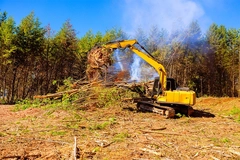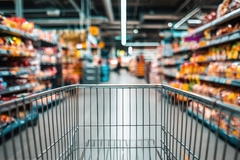
- Industry news
Industry news
- Category news
Category news
- Reports
- Key trends
- Multimedia
- Journal
- Events
- Suppliers
- Home
- Industry news
Industry news
- Category news
Category news
- Reports
- Key trends
- Multimedia
- Events
- Suppliers
How Cargill’s robot dog signals turning point for smart manufacturing
Key takeaways
- Cargill’s robot dog conducts over 10,000 autonomous inspections weekly, detecting equipment issues and safety risks in real time to prevent downtime.
- Spot enhances, not replaces, human expertise by giving operators data-driven visibility and supporting safer, more efficient operations.
- The initiative marks a shift toward predictive, AI-enabled production, showcasing how robotics will drive safety, sustainability, and resilience across global food systems.

Cargill has introduced a four-legged robot, Spot, at its Amsterdam Multiseed crush and refinery plant in the Netherlands to support daily inspections, identify hazards in real time, and enhance operational reliability. Spot uses advanced sensors and real-time data collection to detect equipment and safety risks.
The AI dog performs around 10,000 autonomous inspections weekly, detecting equipment and safety risks, and helps prevent downtime by identifying issues such as overheating, leaks, and ventilation faults.
Chris Kassios, smart manufacturing process lead at Cargill, speaks to us about how Spot positions Cargill at the forefront of safe, efficient, and talent-forward food production, while complementing the labor force and acting as an early warning system that helps keep production safe and smooth.

Cargill is positioning Spot as more than a tool and as part of a broader transformation. What does this signal about the future role of AI and robotics in food manufacturing at scale?
Kassios: Spot is one of several technologies signaling a new era for food manufacturing — one where AI and robotics are integral to how we ensure safety, quality, and operational resilience. For Cargill, it represents a shift from manual oversight to predictive, data-informed, decision-making. The future of food manufacturing will be defined by how effectively people and machines work together. AI and robotics aren’t replacing expertise — they’re amplifying it. Tools like Spot give operators digital visibility and insights that make every shift safer, more efficient, and more sustainable.
How do you envision Spot evolving in capabilities over the next few years, and what kind of tasks could AI-powered robots be handling in food plants by 2030?
Kassios: Spot’s capabilities are advancing at an incredible pace. At our Amsterdam, Netherlands, Multiseed facility, Spot already performs thousands of autonomous inspections each week, using advanced thermal, acoustic, and visual sensors to detect potential equipment issues, leaks, and safety risks in near real time. This technology has become a crucial component in ensuring safe and efficient operations.
We see enormous potential for Spot and other AI-powered robots to take on increasingly complex tasks. These include predictive maintenance, where AI anticipates equipment failures before they happen; quality assurance, through automated visual inspections that enhance food safety and product consistency; and remote operations, allowing robots to safely perform work in hazardous areas under human supervision. Beyond that, integrating these robots with our plant management systems will unlock data-driven decision support, giving us real-time insights that optimize processes and boost performance. By 2030, we expect robots like Spot to routinely handle inspections, environmental monitoring, and even assist in emergency response, enabling our people to focus more on oversight, analysis, and continuous improvement.
What lessons has Cargill learned from deploying Spot that would inform how you scale this technology across other facilities or geographies?
Kassios: The biggest lesson is that technology adoption must start with people, not machines. Success comes from engaging frontline employees early — helping them understand what the robot does, how it complements their work, and giving them ownership in programming and interpreting the data. We’ve also learned that one-size-fits-all doesn’t work. Each site has its own operational rhythm and risk profile, so scaling AI and robotics requires a local mindset backed by global standards in data governance and safety.
Are there any specific performance indicators where you’ve already seen measurable improvement since Spot was deployed?
Kassios: While the pilot is ongoing, we’ve already seen measurable improvements in early detection of maintenance issues, reduced unplanned downtime, and improved equipment reliability. Spot performs roughly 10,000 autonomous inspections per week — a level of consistency and precision that would be impossible through manual rounds alone. In one case, Spot detected a decanter running above safe operating limits, allowing maintenance teams to intervene before failure occurred. In another, it identified bearing temperature fluctuations and prevented downtime. The insights gathered by Spot go beyond identifying problems; they signal a broader shift toward predictive, data-driven operations. By digitalizing tasks in support of our people, we are making work safer, more efficient, and more consistent — all while reinforcing the reliability of our food supply.
How has Spot’s introduction affected employee engagement and morale?
Kassios: Like any new technology, Spot prompted curiosity — and some initial caution. But once employees saw that it wasn’t replacing their roles, rather enhancing their ability to work safely and smartly, attitudes shifted quickly. Operators now take pride in programming Spot’s missions, analyzing inspection data, and using digital insights to drive improvements. It’s created new skill paths and elevated engagement. As one team member put it, “Spot gives us peace of mind overnight and helps us wake up to data, not surprises.” Spot’s introduction has also inspired broader workplace innovation. Its success has encouraged teams to explore new ways of using automation and digitalization to make operations safer, more efficient, and more attractive to new talent. Equally important, the project strengthened collaboration across departments. Operations, reliability, smart manufacturing, and IT teams worked side by side, creating a strong foundation for future innovations.
How do you see AI and robotics influencing the F&B industry’s ability to respond to global challenges — like labor shortages, climate risks, or supply chain volatility?
Kassios: AI and robotics are already becoming essential in addressing these systemic challenges. They help bridge labor gaps by automating repetitive or hazardous tasks, improve resilience by detecting risks earlier, and make production more resource-efficient through precise monitoring and predictive analytics. In an era of climate uncertainty and supply chain complexity, digital tools like Spot provide the visibility and responsiveness that modern food systems demand. They’re part of how we future-proof production while keeping safety and sustainability front and center.
Spot’s deployment at Cargill shows a serious investment in smart tech. Do you believe the food industry as a whole is moving fast enough in this space?
Kassios: The food industry is catching up, but we can — and must — move faster. Technology adoption in our sector has historically been cautious, given the stakes of safety and quality. But as AI and robotics mature, the case for acceleration becomes undeniable. We see digital transformation as a competitive necessity, not an optional innovation. Spot is one example of how we’re rethinking food manufacturing from the ground up — using AI to make our systems not just more efficient, but more human-centered, sustainable, and resilient for the decades ahead.










